Impact of Climate Variability on Blue and Green Water Flows in the Erhai Lake Basin of Southwest China
Abstract
1. Introduction
2. Materials and Methods
2.1. Study Area
2.2. Modeling Approach
2.3. Data Sets and Evaluation
2.4. Climate Change Scenarios and Sensitivity Analysis
3. Results
3.1. Evaluation of CMADS Precipitation and Temperature
3.2. Evaluation of SWAT Simulation
3.3. Spatial and Temporal Variability of Blue and Green Water Flows in the Erhai Lake Basin
3.4. Sensitivity of Blue and Green Water Flows to Climate Change
3.4.1. Sensitivity of Blue and Green Water Flows to Precipitation and Temperature at the Basin Scale
3.4.2. Sensitivity of Blue and Green Water Flows to Precipitation and Temperature at the Sub-Basin Scale
4. Discussion
4.1. Comparison of the Sensitivity of Blue Water Flow and Green Water Flow
4.2. Uncertainty Analysis
4.3. Method for Green Water Flow Estimation
4.4. Impact of Land Use/Cover Change on Blue and Green Water Flow
5. Conclusions
Author Contributions
Funding
Acknowledgments
Conflicts of Interest
References
- Zhuang, X.; Li, Y.; Nie, S.; Fan, Y.; Huang, G. Analyzing climate change impacts on water resources under uncertainty using an integrated simulation—Optimization approach. J. Hydrol. 2018, 556, 523–538. [Google Scholar] [CrossRef]
- Miara, A.; Macknick, J.E.; Vörösmarty, C.J.; Tidwell, V.C.; Newmark, R.; Fekete, B. Climate and water resource change impacts and adaptation potential for US power supply. Nat. Clim. Chang. 2017, 7, 793–798. [Google Scholar] [CrossRef]
- Liang, W.; Bai, D.; Wang, F.; Fu, B.; Yan, J.; Wang, S.; Yang, Y.; Long, D.; Feng, M. Quantifying the impacts of climate change and ecological restoration on streamflow changes based on a Budyko hydrological model in China’s Loess Plateau. Water Resour. Res. 2015, 51, 6500–6519. [Google Scholar] [CrossRef]
- Chen, Y.; Li, Z.; Fan, Y.; Wang, H.; Deng, H. Progress and prospects of climate change impacts on hydrology in the arid region of northwest China. Environ. Res. 2015, 139, 11–19. [Google Scholar] [CrossRef] [PubMed]
- Mishra, V.; Kumar, R.; Shah, H.L.; Samaniego, L.; Eisner, S.; Yang, T. Multi-model assessment of sensitivity and uncertainty of evapotranspiration and a proxy for available water resources under climate change. Clim. Chang. 2017, 141, 451–465. [Google Scholar] [CrossRef]
- Gohar, A.A.; Cashman, A. A methodology to assess the impact of climate variability and change on water resources, food security and economic welfare. Agric. Syst. 2016, 147, 51–64. [Google Scholar] [CrossRef]
- Simonovic, S.P. Bringing future climatic change into water resources management practice today. Water Resour. Manag. 2017, 31, 2933–2950. [Google Scholar] [CrossRef]
- Arnell, N.W. Climate change and global water resources. Glob. Environ. Chang. 1999, 9, 31–49. [Google Scholar] [CrossRef]
- Huntington, T.G. Evidence for intensification of the global water cycle: Review and synthesis. J. Hydrol. 2006, 319, 83–95. [Google Scholar] [CrossRef]
- Chen, G.; Zhao, W. Green water and its research progresses. Adv. Earth Sci. 2006, 21, 221–227. [Google Scholar]
- Schuol, J.; Abbaspour, K.C.; Yang, H.; Srinivasan, R.; Zehnder, A.J.B. Modeling blue and green water availability in Africa. Water Resour. Res. 2008, 44, W07406. [Google Scholar] [CrossRef]
- Vanham, D. A holistic water balance of Austria-how does the quantitative proportion of urban water requirements relate to other users? Water Sci. Technol. 2012, 66, 549–555. [Google Scholar] [CrossRef] [PubMed]
- Liu, J.; Yang, H. Spatially explicit assessment of global consumptive water uses in cropland: Green and blue water. J. Hydrol. 2009, 384, 187–197. [Google Scholar] [CrossRef]
- Zang, C.; Liu, J. Trend analysis for the flows of green and blue water in the Heihe River basin, northwestern China. J. Hydrol. 2013, 502, 27–36. [Google Scholar] [CrossRef]
- Ding, W. A study on the characteristics of climate change around the Erhai area, China. Resour. Environ. Yangtze Basin 2016, 25, 599–605. (In Chinese) [Google Scholar]
- Huang, H.; Wang, Y.; Li, Q. Climatic characteristics over Erhai Lake basin in the late 50 years and the impact on water resources of Erhai Lake. Meteorol. Mon. 2013, 39, 436–442. (In Chinese) [Google Scholar]
- Li, W.; Yang, C.; Liu, E.; Peng, Z.; Liu, Q. Multiple time scale analysis of water resources in Erhai Lake Basin in recent 59 years. Chin. J. Agrometeorol. 2010, 31, 10–15. (In Chinese) [Google Scholar]
- Li, Y.; Li, B.; Zhang, K.; Zhu, J.; Yang, Q. Study on spatiotemporal distribution characteristics of annual precipitation of Erhai Basin. J. China Inst. Water Resour. Hydropower Res. 2017, 15, 234–240. (In Chinese) [Google Scholar]
- Arias, R.; RodríguezBlanco, M.L.; Taboadacastro, M.M.; Nunes, J.P.; Keizer, J.J.; Taboadacastro, M.T. Water resources response to changes in temperature, rainfall and CO2 concentration: A first approach in NW Spain. Water 2014, 6, 3049–3067. [Google Scholar] [CrossRef]
- Falkenmark, M. Land-water linkages: A synopsis. Land and water integration and river basin management. FAO Land Water Bull. 1995, 1, 15–16. [Google Scholar]
- Zhang, W.; Zha, X.; Li, J.; Liang, W.; Ma, Y.; Fan, D.; Li, S. Spatiotemporal change of blue water and green water resources in the headwater of Yellow River Basin, China. Water Resour. Manag. 2014, 28, 4715–4732. [Google Scholar] [CrossRef]
- Chen, C.; Hagemann, S.; Liu, J. Assessment of impact of climate change on the blue and green water resources in large river basins in China. Environ. Earth Sci. 2015, 74, 6381–6394. [Google Scholar] [CrossRef]
- Lee, M.H.; Bae, D.H. Climate change impact assessment on green and blue water over Asian monsoon region. Water Resour. Manag. 2015, 29, 2407–2427. [Google Scholar] [CrossRef]
- Glavan, M.; Pintar, M.; Volk, M. Land use change in a 200-year period and its effect on blue and green water flow in two Slovenian Mediterranean catchments-lessons for the future. Hydrol. Process. 2013, 27, 3964–3980. [Google Scholar] [CrossRef]
- Fazeli, F.I.; Farzaneh, M.R.; Besalatpour, A.A.; Salehi, M.H.; Faramarzi, M. Assessment of the impact of climate change on spatiotemporal variability of blue and green water resources under CMIP3 and CMIP5 models in a highly mountainous watershed. Theor. Appl. Climatol. 2018. [Google Scholar] [CrossRef]
- Zhou, F.; Xu, Y.; Chen, Y.; Xu, C.; Gao, Y.; Du, J. Hydrological response to urbanization at different spatio-temporal scales simulated by coupling of CLUE-S and the SWAT model in the Yangtze River Delta region. J. Hydrol. 2013, 485, 113–125. [Google Scholar] [CrossRef]
- Fan, M.; Shibata, H. Simulation of watershed hydrology and stream water quality under landuse and climate change scenarios in Teshio River watershed, northern Japan. Ecol. Indic. 2015, 50, 79–89. [Google Scholar] [CrossRef]
- Villarini, G.; Krajewski, W.F.; Smith, J.A. New paradigm for statistical validation of satellite precipitation estimates: Application to a large sample of the TMPA 0.25 3-hourly estimates over Oklahoma. J. Geophys. Res. Atmos. 2009, 114. [Google Scholar] [CrossRef]
- Nijssen, B.; Lettenmaier, D.P. Effect of precipitation sampling error on simulated hydrological fluxes and states: Anticipating the Global Precipitation Measurement satellites. J. Geophys. Res. Atmos. 2004, 109. [Google Scholar] [CrossRef]
- Conti, F.L.; Hsu, K.L.; Noto, L.V.; Sorooshian, S. Evaluation and comparison of satellite precipitation estimates with reference to a local area in the Mediterranean Sea. Atmos. Res. 2014, 138, 189–204. [Google Scholar] [CrossRef]
- Li, C.; Tang, G.; Hong, Y. Cross-evaluation of ground-based, multi-satellite and reanalysis precipitation products: Applicability of the Triple Collocation method across Mainland China. J. Hydrol. 2018, 562, 71–83. [Google Scholar] [CrossRef]
- Meng, X.; Wang, H. Significance of the China meteorological assimilation driving datasets for the SWAT Model (CMADS) of East Asia. Water 2017, 9, 765. [Google Scholar] [CrossRef]
- Meng, X.; Wang, H.; Shi, C.; Wu, Y.; Ji, X. Establishment and Evaluation of the China Meteorological Assimilation Driving Datasets for the SWAT Model (CMADS). Water 2018, 10, 1555. [Google Scholar] [CrossRef]
- Meng, X.; Wang, H.; Cai, S.; Zhang, X.; Leng, G.; Lei, X.; Shi, C.; Liu, S.; Shang, Y. The China Meteorological Assimilation Driving Datasets for the SWAT Model (CMADS) Application in China: A Case Study in Heihe River Basin. Preprints 2016. [Google Scholar] [CrossRef]
- Meng, X.; Wang, H.; Wu, Y.; Long, A.; Wang, J.; Shi, C.; Ji, X. Investigating spatiotemporal changes of the land-surface processes in Xinjiang using high-resolution CLM3.5 and CLDAS: Soil temperature. Sci. Rep. 2017, 7, 13286. [Google Scholar] [CrossRef] [PubMed]
- Meng, X.; Dan, L.; Liu, Z. Energy balance-based SWAT model to simulate the mountain snowmelt and runoff—Taking the application in Juntanghu watershed (China) as an example. J. Mt. Sci. 2015, 12, 368–381. [Google Scholar] [CrossRef]
- Meng, X.; Wang, H.; Lei, X.; Cai, S.; Wu, H. Hydrological Modeling in the Manas River Basin Using Soil and Water Assessment Tool Driven by CMADS. Tehnički Vjesnik 2017, 24, 525–534. [Google Scholar]
- Wang, Y.; Meng, X. Snowmelt runoff analysis under generated climate change scenarios for the Juntanghu River basin in Xinjiang, China. Tecnol. Y Cienc. Agua 2016, 7, 41–54. [Google Scholar]
- Meng, X. Simulation and spatiotemporal pattern of air temperature and precipitation in Eastern Central Asia using RegCM. Sci. Rep. 2018, 8, 3639. [Google Scholar] [CrossRef] [PubMed]
- Meng, X. Spring Flood Forecasting Based on the WRF-TSRM mode. Tehnički Vjesnik 2018, 25, 27–37. [Google Scholar]
- Vu, T.; Li, L.; Jun, K. Evaluation of MultiSatellite Precipitation Products for Streamflow Simulations: A Case Study for the Han River Basin in the Korean Peninsula, East Asia. Water 2018, 10, 642. [Google Scholar] [CrossRef]
- Gao, X.; Zhu, Q.; Yang, Z.; Wang, H. Evaluation and hydrological application of CMADS against TRMM 3B42V7, PERSIANN-CDR, NCEP-CFSR, and gauge-based datasets in Xiang River Basin of China. Water 2018, 10, 1225. [Google Scholar] [CrossRef]
- Zhou, S.; Wang, Y.; Chang, J.; Guo, A.; Li, Z. Investigating the dynamic influence of hydrological model parameters on runoff simulation using sequential uncertainty fitting-2-based multilevel-factorial-analysis method. Water 2018, 10, 1177. [Google Scholar] [CrossRef]
- Tian, Y.; Zhang, K.; Xu, Y.-P.; Gao, X.; Wang, J. Evaluation of potential evapotranspiration based on CMADS reanalysis dataset over China. Water 2018, 10, 1126. [Google Scholar] [CrossRef]
- Hu, Y.; Peng, J.; Liu, Y.; Tian, L. Integrating ecosystem services trade-offs with paddy land-to-dry land decisions: A scenario approach in Erhai Lake basin, southwest China. Sci. Total Environ. 2018, 625, 849–860. [Google Scholar] [CrossRef] [PubMed]
- Crook, D.; Elvin, M.; Jones, R.; Ji, S.; Foster, G.; Dearing, J. The History of Irrigation and Water Control in China’s Erhai Catchment: Mitigation and Adaptation to Environmental Change. In Mountains: Sources of Water, Sources of Knowledge; Springer: Berlin, Germany, 2008. [Google Scholar]
- Nash, J.E.; Sutcliffe, J.V. River flow forecasting through conceptual models part I-A discussion of principles. J. Hydrol. 1970, 10, 282–290. [Google Scholar] [CrossRef]
- Gupta, H.; Sorooshian, S.; Yapo, P. Status of automatic calibration for hydrologic models: Comparison with multilevel expert calibration. J. Hydrol. Eng. 1999, 4, 135–143. [Google Scholar] [CrossRef]
- Kumar, S.; Merwade, V. Impact of watershed subdivision and soil data resolution on SWAT model calibration and parameter uncertainty. J. Am. Water Resour. Assoc. 2009, 45, 1179–1196. [Google Scholar] [CrossRef]
- Yin, J.; Yuan, Z.; Yan, D.; Yang, Z.; Wang, Y. Addressing climate change impacts on streamflow in the Jinsha River Basin based on CMIP5 Climate Models. Water 2018, 10, 910. [Google Scholar] [CrossRef]
- Jiang, S.; Ren, L.; Yong, B.; Yuan, F.; Gong, L.; Yang, X. Hydrological evaluation of the TRMM multi-satellite precipitation estimates over the Mishui basin. Adv. Water Sci. 2014, 25, 641–649. (In Chinese) [Google Scholar]
- Zheng, H.; Zhang, L.; Zhu, R.; Liu, C.; Sato, Y.; Fukushima, Y. Responses of streamflow to climate and land surface change in the headwaters of the Yellow River Basin. Water Resour. Res. 2009, 45, W00A19. [Google Scholar] [CrossRef]
- Lan, Y.; Zhao, G.; Zhang, Y.; Wen, J.; Hu, X.; Liu, J.; Gu, M.; Chang, J.; Ma, J. Response of runoff in the headwater region of the Yellow River to climate change and its sensitivity analysis. J. Geogr. Sci. 2010, 20, 848–860. [Google Scholar] [CrossRef]
- Liu, Q.; Mcvicar, T.R. Assessing climate change induced modification of penman potential evaporation and runoff sensitivity in a large water-limited basin. J. Hydrol. 2012, 464, 352–362. [Google Scholar] [CrossRef]
- Xu, C.; Singh, V. Evaluation of three complementary relationship evapotranspiration models by water balance approach to estimate actual regional evapotranspiration in different climatic regions. J. Hydrol. 2005, 308, 105–121. [Google Scholar] [CrossRef]
- Wang, C.; Zhou, X. Effect of the recent climate change on water resource in Heihe river basin. J. Arid Land Resour. Environ. 2010, 24, 60–65. (In Chinese) [Google Scholar]
- Guo, Q.; Yang, Y.; Chen, X.; Chen, Z. Annual Variation of Heihe River Runoff during 1957–2008. Prog. Geogr. 2011, 30, 550–556. (In Chinese) [Google Scholar]
- Zang, C.; Liu, J.; Velde, M.; Kraxner, F. Assessment of spatial and temporal patterns of green and blue water flows under natural conditions in inland river basins in Northwest China. Hydrol. Earth Syst. Sci. 2012, 16, 2859–2870. [Google Scholar] [CrossRef]
- Jones, R.N.; Chiew, F.H.S.; Boughton, W.C.; Zhang, L. Estimating the sensitivity of mean annual runoff to climate change using selected hydrological models. Adv. Water Resour. 2006, 29, 1419–1429. [Google Scholar] [CrossRef]
- Bao, Z.; Zhang, J.; Liu, J.; Wang, G.; Yan, X.; Wang, X.; Zhang, L. Sensitivity of hydrological variables to climate change in the Haihe river basin, China. Hydrol. Process. 2012, 26, 2294–2306. [Google Scholar] [CrossRef]
- Yuan, Z.; Yan, D.; Yang, Z.; Yin, J.; Zhang, C.; Yuan, Y. Projection of surface water resources in the context of climate change in typical regions of China. Hydrol. Sci. J. 2017, 62, 283–293. [Google Scholar] [CrossRef]
- Budyko, M.I. Climatic factors of the external physical-geographical processes. Gl Geofiz Obs. 1950, 19, 25–40. (In Russian) [Google Scholar]
- Brutsaert, W.; Parlange, M.B. Hydrologic cycle explains the evaporation paradox. Nature 1998, 396, 30. [Google Scholar] [CrossRef]
- Golubev, V.S.; Lawrimore, J.H.; Groisman, P.Y.; Speranskaya, N.A.; Zhuravin, S.A.; Menne, M.J.; Peterson, T.C.; Thomas, C.; Malone, R.W. Evaporation changes over the contiguous united states and the former USSR: A reassessment. Geophys. Res. Lett. 2001, 28, 2665–2668. [Google Scholar] [CrossRef]
- Xu, C.; Gong, L.; Jiang, T.; Chen, D.; Singh, V.P. Analysis of spatial distribution and temporal trend of reference evapotranspiration and pan evaporation in Changjiang (Yangtze river) catchment. J. Hydrol. 2006, 327, 81–93. [Google Scholar] [CrossRef]
- Yu, P.; Yang, T.; Chou, C. Effects of climate change on evapotranspiration from paddy fields in southern Taiwan. Clim. Chang. 2002, 54, 165–179. [Google Scholar] [CrossRef]
- Burn, D.H.; Hesch, N.M. Trends in evaporation for the Canadian prairies. J. Hydrol. 2007, 336, 61–73. [Google Scholar] [CrossRef]
- Dinpashoh, Y.; Jhajharia, D.; Fakheri-Fard, A.; Singh, V.P.; Kahya, E. Trends in reference crop evapotranspiration over Iran. J. Hydrol. 2011, 399, 422–433. [Google Scholar] [CrossRef]
- Monteith, J.L. Evaporation and environment. In Proceedings of the 19th Symposium of the Society for Experimental Biology, New York, NY, USA, 1 January 1965; Cambridge University Press: Cambridge, UK, 1965; pp. 205–233. [Google Scholar]
- Allen, R.G.; Jensen, M.E.; Wright, J.L.; Burman, R.D. Operational estimates of reference evapotranspiration. Agron. J. 1989, 81, 650–662. [Google Scholar] [CrossRef]
- Priestley, C.H.B.; Taylor, R.J. On the assessment of surface heat flux and evaporation using large-scale parameters. Mon. Weather Rev. 1972, 100, 81–92. [Google Scholar] [CrossRef]
- Hargreaves, G.L.; Hargreaves, G.H.; Riley, J.P. Agricultural benefits for Senegal River Basin. J. Irrig. Drain. Eng. 1985, 111, 113–124. [Google Scholar] [CrossRef]
- Allen, R.G.; Pereira, L.S.; Howell, T.A.; Jensen, M.E. Evapotranspiration information reporting: I. Factors governing measurement accuracy. Agric. Water Manag. 2011, 98, 899–920. [Google Scholar] [CrossRef]
- Nagler, P.L.; Glenn, E.P.; Kim, H.; Emmerich, W.; Scott, R.L.; Huxman, T.E.; Huete, A.R. Relationship between evapotranspiration and precipitation pulses in a semiarid rangeland estimated by moisture flux towers and MODIS vegetation indices. J. Arid. Environ. 2007, 70, 443–462. [Google Scholar] [CrossRef]
- Sun, L.; Seidou, O.; Nistor, I.; Liu, K. Review of the Kalman type hydrological data assimilation. Hydrol. Sci. J. 2016, 61, 2348–2366. [Google Scholar] [CrossRef]
- Zhao, A.; Zhu, X.; Liu, X.; Pan, Y.; Zuo, D. Impacts of land use change and climate variability on green and blue water resources in the Weihe river basin of northwest china. Catena 2016, 137, 318–327. [Google Scholar] [CrossRef]
- Sajikumar, N.; Remya, R.S. Impact of land cover and land use change on runoff characteristics. J. Environ. Manag. 2015, 161, 460–468. [Google Scholar] [CrossRef] [PubMed]
- Deng, Z.; Zhang, X.; Li, D.; Pan, G. Simulation of land use/land cover change and its effects on the hydrological characteristics of the upper reaches of the Hanjiang Basin. Environ. Earth Sci. 2015, 73, 1119–1132. [Google Scholar] [CrossRef]
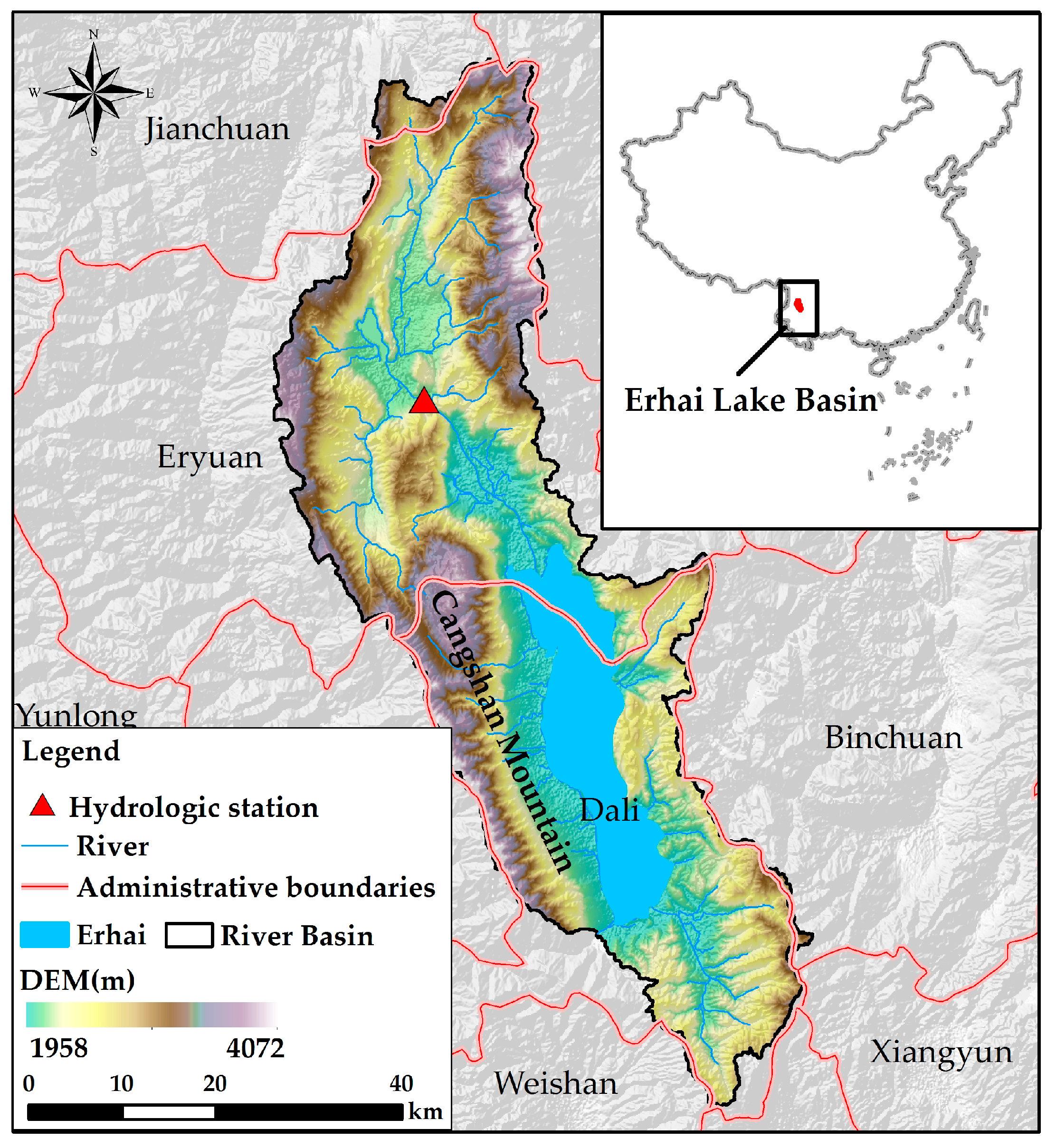

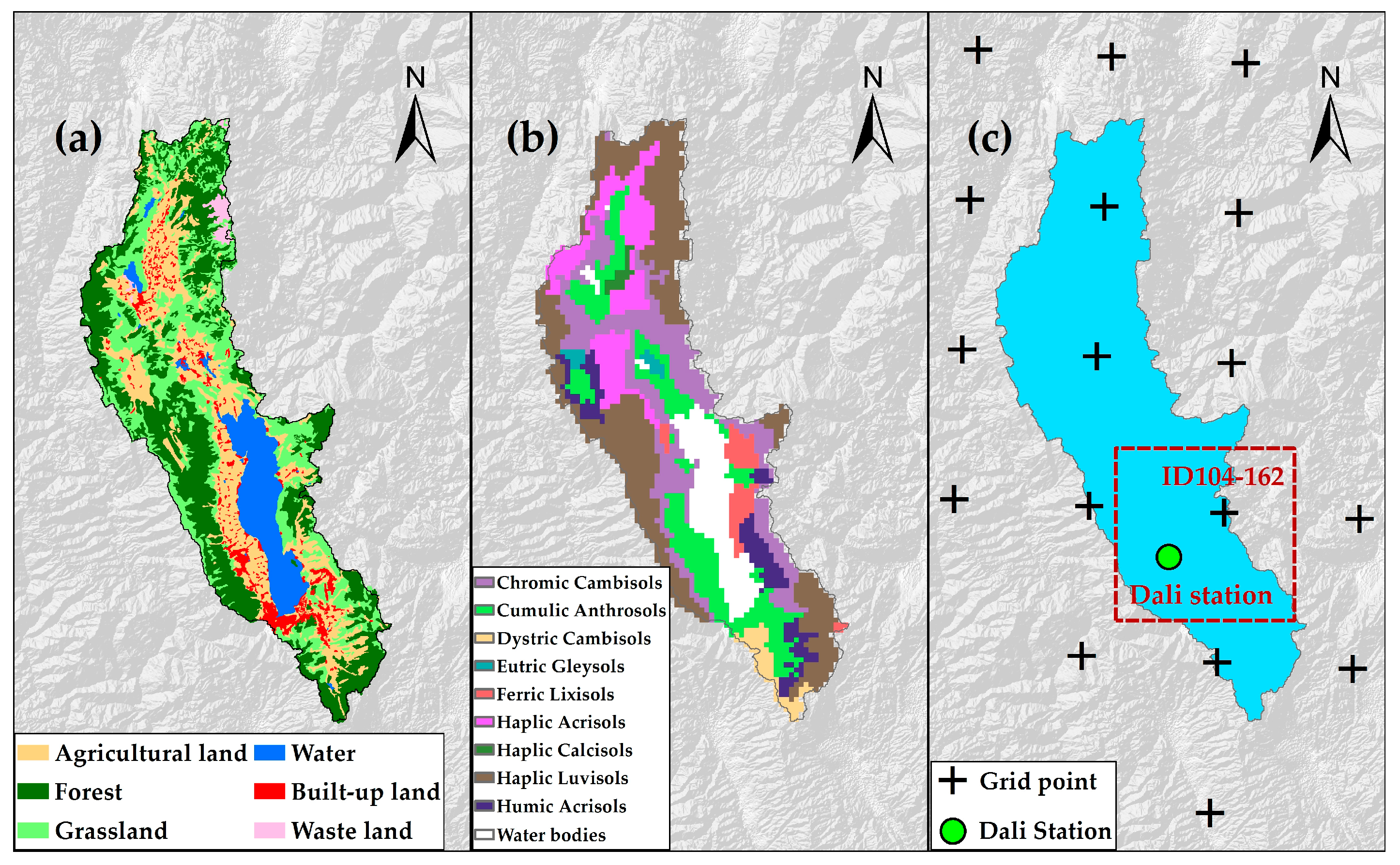
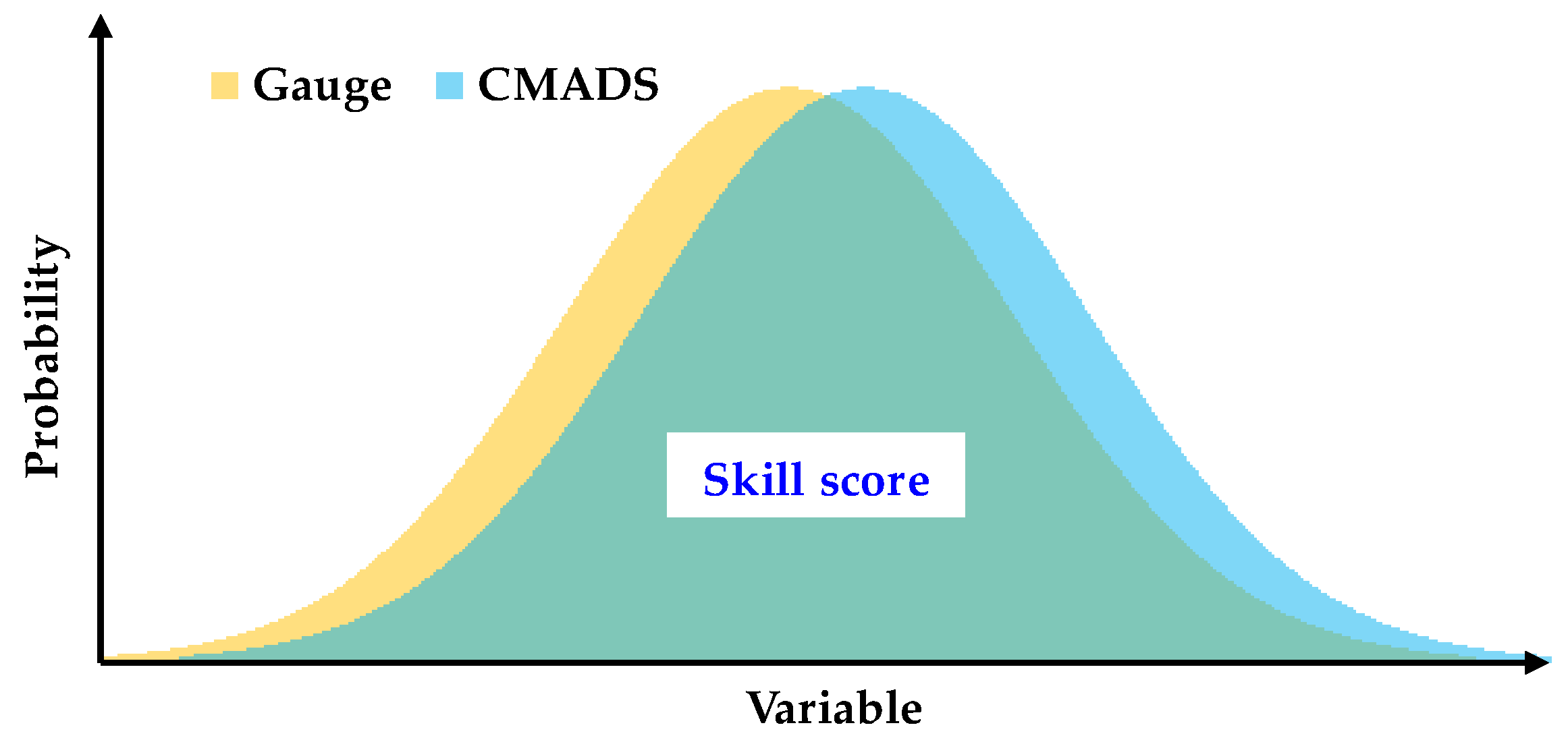


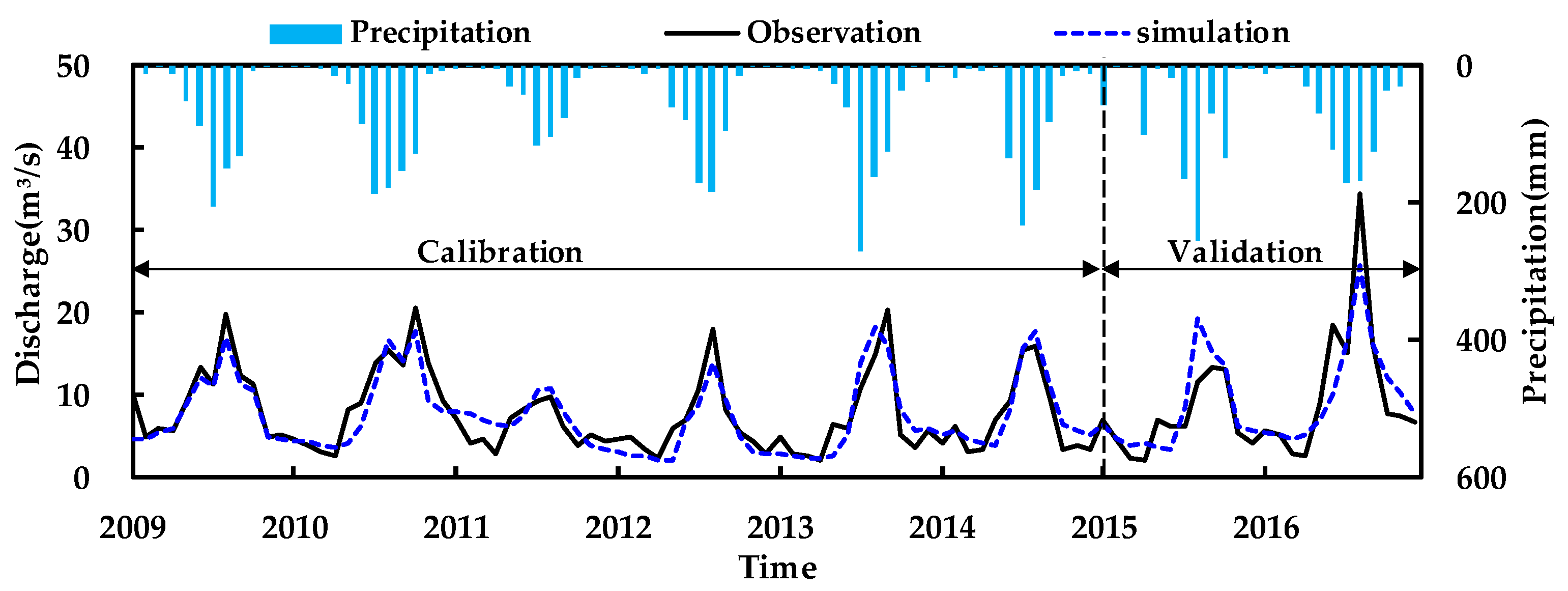


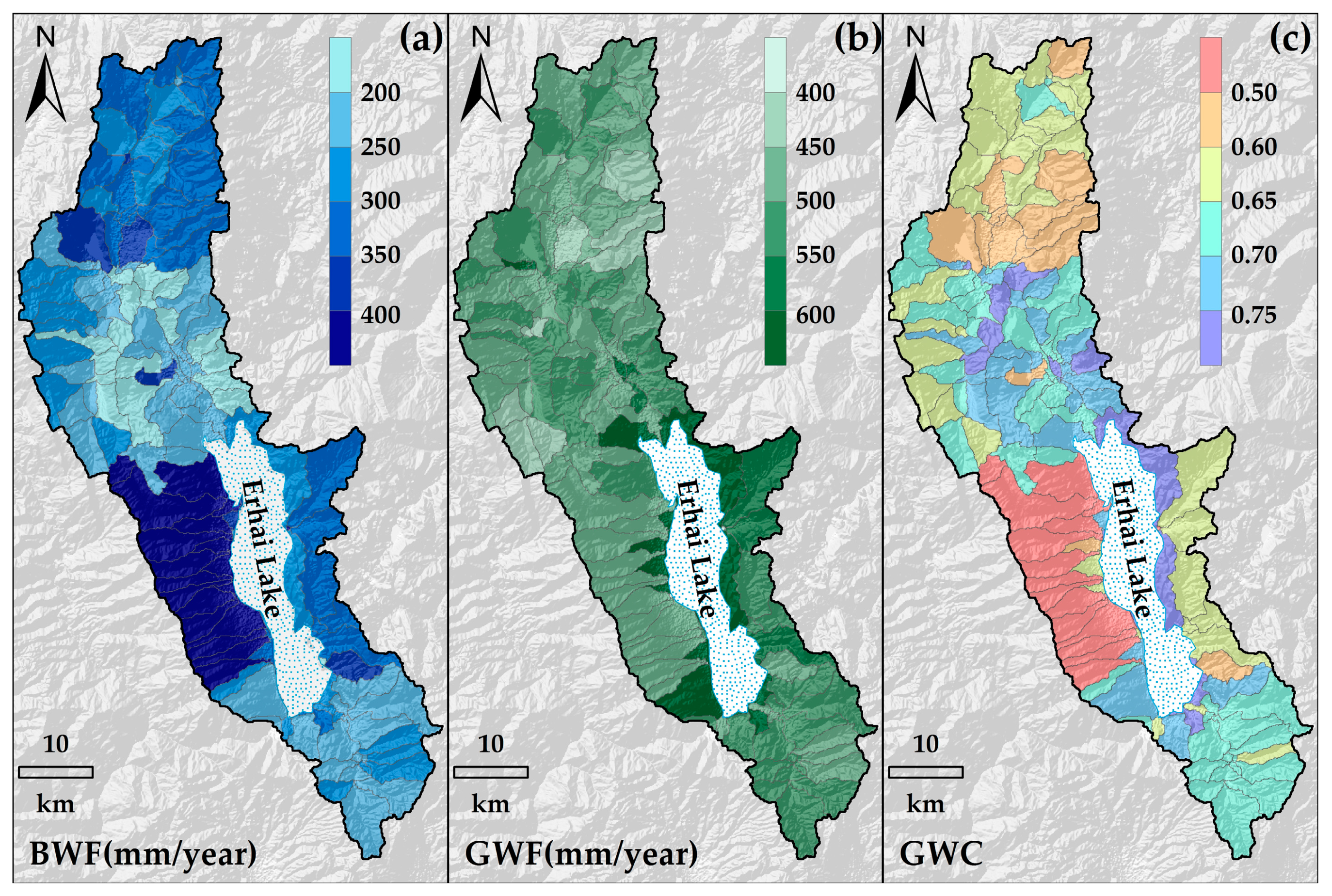
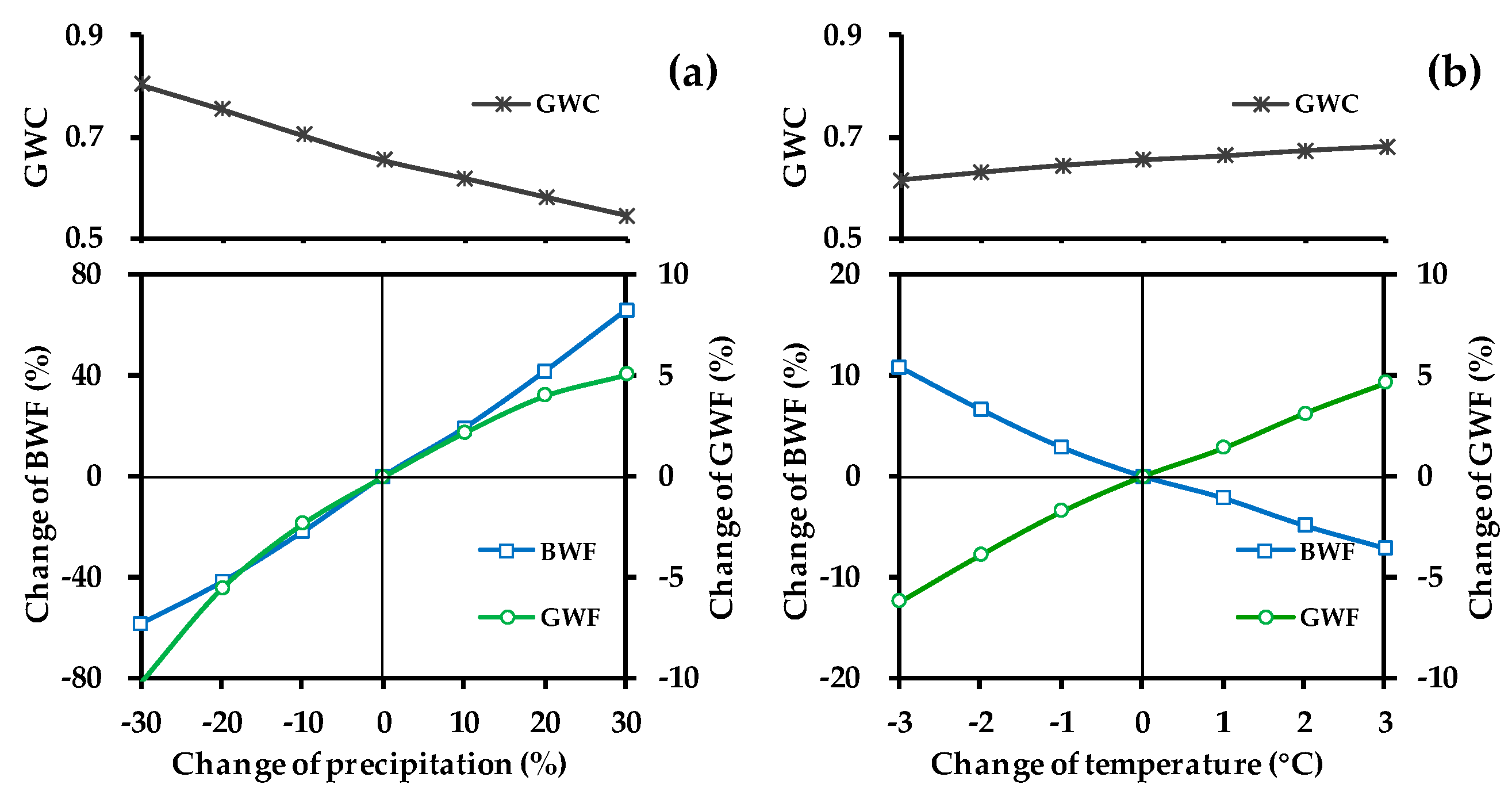
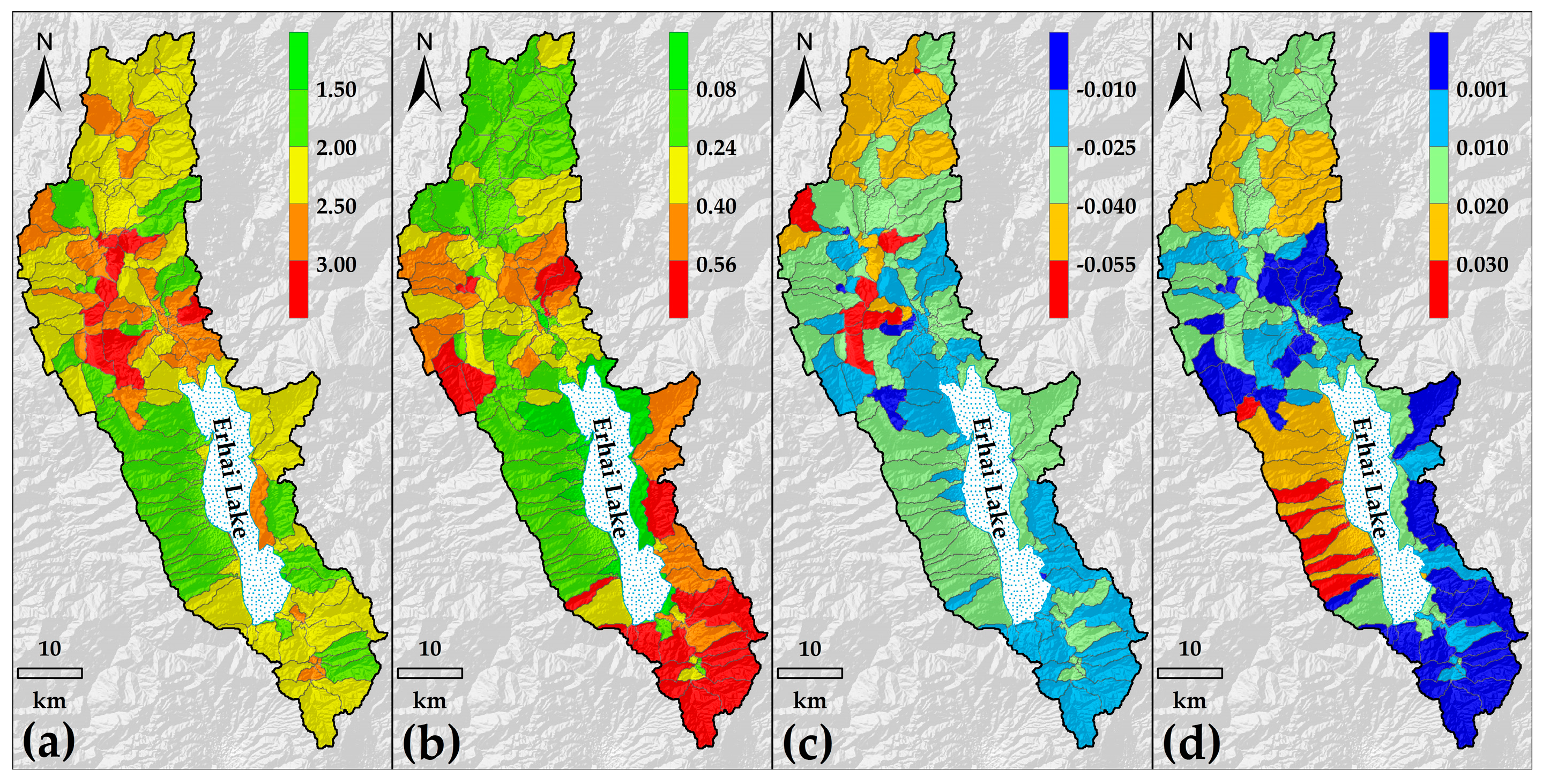
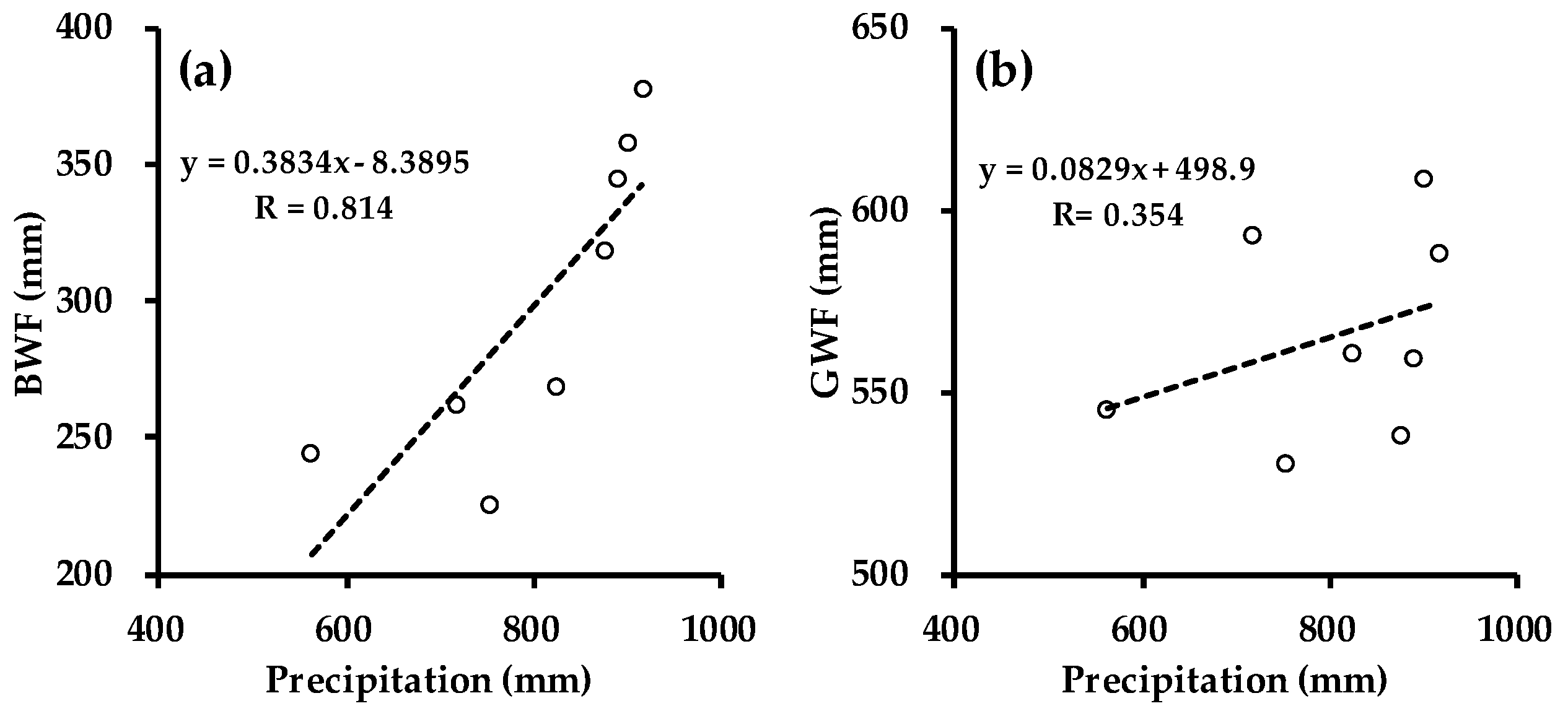
| Period | ENS | R2 | RE (%) |
|---|---|---|---|
| Calibration (2009 to 2014) | 0.802 | 0.808 | −3.7 |
| Validation (2015 to 2016) | 0.751 | 0.754 | 2.9 |
| Land Use | Year 1980 | Year 2015 | Change | |||
|---|---|---|---|---|---|---|
| Area (km2) | Percentage (%) | Area (km2) | Percentage (%) | Area (km2) | Percentage (%) | |
| Agricultural land | 651.8 | 25.5 | 582.0 | 22.8 | −69.8 | −10.7 |
| Forest | 838.8 | 32.9 | 851.5 | 33.4 | 12.8 | 1.5 |
| Grassland | 703.8 | 27.6 | 693.8 | 27.2 | −10.0 | −1.4 |
| Water | 265.9 | 10.4 | 261.0 | 10.2 | −4.9 | −1.8 |
| Built-up land | 67.0 | 2.6 | 134.5 | 5.3 | 67.5 | 100.8 |
| Waste land | 25.0 | 1.0 | 29.4 | 1.2 | 4.4 | 17.5 |
© 2019 by the authors. Licensee MDPI, Basel, Switzerland. This article is an open access article distributed under the terms and conditions of the Creative Commons Attribution (CC BY) license (http://creativecommons.org/licenses/by/4.0/).
Share and Cite
Yuan, Z.; Xu, J.; Meng, X.; Wang, Y.; Yan, B.; Hong, X. Impact of Climate Variability on Blue and Green Water Flows in the Erhai Lake Basin of Southwest China. Water 2019, 11, 424. https://doi.org/10.3390/w11030424
Yuan Z, Xu J, Meng X, Wang Y, Yan B, Hong X. Impact of Climate Variability on Blue and Green Water Flows in the Erhai Lake Basin of Southwest China. Water. 2019; 11(3):424. https://doi.org/10.3390/w11030424
Chicago/Turabian StyleYuan, Zhe, Jijun Xu, Xianyong Meng, Yongqiang Wang, Bo Yan, and Xiaofeng Hong. 2019. "Impact of Climate Variability on Blue and Green Water Flows in the Erhai Lake Basin of Southwest China" Water 11, no. 3: 424. https://doi.org/10.3390/w11030424
APA StyleYuan, Z., Xu, J., Meng, X., Wang, Y., Yan, B., & Hong, X. (2019). Impact of Climate Variability on Blue and Green Water Flows in the Erhai Lake Basin of Southwest China. Water, 11(3), 424. https://doi.org/10.3390/w11030424






